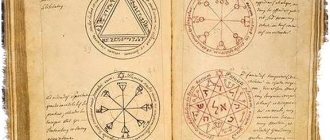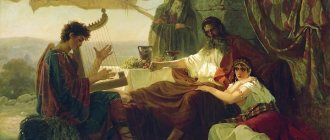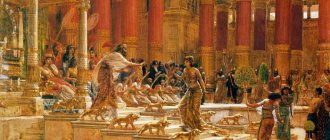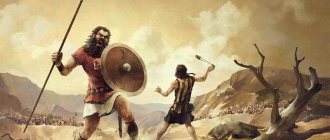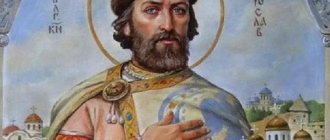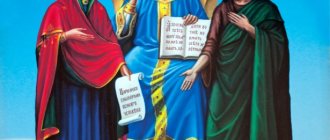photo: daverphillips.com
Solomon's Temple will go down in history as a grandiose structure. In fact, in size it was no larger than the Assumption Cathedral in the Moscow Kremlin, and, by the way, the interior was designed very similar.
Why exactly did King Solomon build the first temple of God for his people? What was the legendary wisdom of King Solomon? Could he actually be the author of the Book of Ecclesiastes and the Song of Songs? How many wives were in King Solomon's harem and how did they force him to worship idols, and why is Solomon still considered an ideal ruler?
The great Israeli king David, in his declining years, is trying to be overthrown from the throne by his eldest sons. First Absalom, then Adonijah, but both are defeated. David appoints as his successor his 10th son, Solomon, born of Bathsheba, the same strange wife whom the king once brought to the palace.
“Even in the Gospel, the evangelist Matthew, conducting the genealogy of Jesus Christ, specifically emphasizes that Bathsheba is the same, another man’s wife, taken by David, who was the mother of Solomon. The future king and, accordingly, the ancestor of Christ according to the flesh. Perhaps this is noted because it is very important to draw not an ideal portrait of an ideal king, but a realistic portrait of a living person and draw some lessons from this.”
Prince Solomon, who knew neither wars nor hardships, ascends the throne as a twenty-year-old youth. According to the Bible, the Lord God himself appears to the young king in a dream and promises to fulfill his every desire. Solomon asks for one thing - wisdom, for which he receives wealth and glory in addition.
“In our tradition, Solomon is the most intelligent person who has ever lived on earth. According to legend, he could speak not only all human languages, but also animal languages. He was also a fair judge. For example, one day two women came to him with one child. They both recently gave birth, but one of them had a child who died, and each insisted that the living child was her child. Solomon said: “Cut the child and give each one half.” And the woman whose child had died said, “Okay, let’s do it.” - And the other woman said. “No, no, give the child to her, just don’t kill him.” And so it immediately became clear which of them was the real mother,” Amir Orly, biblical scholar, Jerusalem.
Solomon is considered the author of 3,000 proverbs and several biblical books: Song of Songs, Proverbs of Solomon and Ecclesiastes.
“We don’t know exactly about some of them, how much they are really connected with the name of Solomon. One of them itself, already in the first line, calls itself the parable of Solomon, the son of David. But we do not know exactly how connected the book “Song of Songs” is with the personality of Solomon. There is the book “Ecclesiastes”, this man, the lyrical hero, on whose behalf the story is told, is very similar to Solomon. A rich, glorious king who had achieved wisdom and at the end was somewhat tired of life. He experienced everything, and he realized that, in general, it doesn’t matter much, all these pleasures, all these fame, wealth, but you need to fear the Lord, you need to serve him, and this, in general, is the only conclusion, quite obvious from his entire life.
Maybe this is the work of Solomon, maybe this is a lyrical story, like, for example, Russian epics, they tell about Vladimir the Red Sun, about Ilya Muromets. Ilya Muromets is a historical character; he has a grave in the Kiev Pechersk Lavra, but it is unlikely that he literally did everything that the epics attribute to him. There is such a point of view that these three books reflect three ages of life: in his youth, Solomon writes the “Song of Songs” about love for a beautiful girl, in his mature years “Proverbs”, reflections on how to manage your home and govern the state at the same time. And in old age – “Ecclesiastes” is like such a sad summing up: everything is vanity and vanity of vanities, but only in God can you find some kind of hope,” - Andrei Desnitsky, biblical scholar, Institute of Oriental Studies of the Russian Academy of Sciences.
Be that as it may, Solomon for the Jewish people is, first of all, an ideal king. His nearly forty-year reign would be an era of stability and prosperity, Israel's golden age.
“The economy flourished under him, and he also established trade with neighboring countries. It is possible that he was quite peaceful, but at the beginning of his reign he dealt with his political opponents - those who posed a threat to him, but much less than his father David, perhaps also because the situation in the kingdom was different. And so it was a peaceful reign, there was an era of prosperity.”
Unlike his father, Solomon does not seek new conquests, and with him the people live calmly, each under his own vineyard and under his own fig tree. He carries out reforms one after another, establishes universal military service, creates a tax service, and opens a school of sages.
Solomon
Solomon had the strongest army in the region, but he never fought. The king was engaged in international trade, and Solomon was the richest and most famous man of his time. Fundamentally, Solomon's trade was based on the absolutely unique location of the land of Israel, in purely geopolitical terms. The land of Israel is a place in the narrowest, most sensitive part of the fertile crescent, layers of fertile lands connecting Egypt and Mesopotamia, and on the other hand, the land of Israel, until the Suez Canal was dug, is the shortest land route between the Mediterranean basin and the Indian basin ocean. Japanese cars still use this to this day; getting to Europe is cheaper than through the Suez Canal. Exactly the same thing happened during the time of King Solomon, and the king, thanks to his trade connections, was able to establish a trading empire. He supplied spices, gold and other goods from India and Africa to the Mediterranean people.
Take a look at the location of Israel on the world map - a unique state whose northern part, its head, rests on Europe, one side on Asia, and the other on Africa. Israel lies at the crossroads of the world. It is like a center that connects them, a point from which the rays diverge in all directions.
Reign of Solomon
Solomon benefited from this position. He sent merchants to the North, South, East - all over the world. He was greatly respected by other kings, even the Egyptian Pharaoh, at that time a much more powerful ruler, gave Solomon his daughter as a wife.
The daughter of the pharaoh is a very profitable match. This political marriage ensures peace and trade relations with the largest power - Egypt. Solomon also establishes good neighborly relations with other countries through marriage; he has many wives. According to legend, the Queen of Sheba herself comes to Solomon on a diplomatic visit.
Solomon and the Queen of Sheba in a fresco by Piero della Francesca
When she arrived in Israel, she brought many gifts: ivory, gold, monkeys and other incredible things. Ethiopians believe that Solomon also gave her a gift, which she carried away in her belly, he gave her a child, and when she returned home, a boy was born, who was named Menelik. It was he who became the founder of the Ethiopian dynasty, which continues to this day. Thus, one of the most ancient dynasties in the world began here in Jerusalem with King Solomon.
Solomon: biography
A legend that helps some people cope with stressful situations says that a long time ago there lived King Solomon. The life of this wise ruler was not calm, so he turned to the court philosopher for advice. The Thinker told his master about a priceless magic ring on which was engraved “Everything passes.”
“When you feel great anger or great joy, look at this inscription and it will sober you up. In this you will find salvation from passions!” the sage used to say to the king.
Much time passed, Solomon pacified his anger with the help of this precious gift. But one day, looking at this laconic inscription, Solomon did not calm down, but, on the contrary, lost his temper. And then the enraged king tore the ring off his finger in the hope of throwing it further into the pond, but noticed that on the back of the jewelry it was written “This too shall pass.”
Ring of Solomon
There are debates about the biography of King Solomon to this day. Some believe that the son of David actually lived, others are sure that the wise ruler is a biblical falsification. Be that as it may, Solomon is an integral character of the Christian and Islamic (Suleiman) religions, who left a mark on culture: his image is used in paintings, prose, poetry, films and cartoons.
Temple of Solomon
King Solomon's life's work was to build the temple of the magnificent House of the Lord, where the Ark of the Covenant would be kept and sacrifices would be made to the one God. Until now, while the Jewish people wandered and fought, the abode of the Almighty was a tent - a tabernacle, now the time has come to build a temple, one for all.
“This is a very important point that there should be one temple, just as before there was one tabernacle. Today we have the opportunity, of course, to build in Christianity, in any tradition, as many churches as we want in absolutely any place. Then it was important to emphasize the unity of the cult - God is one. There is only one place where he is worshiped, the unity of the cult ultimately means the unity of faith: but there is only one place, only one rite, only one group of priests and, therefore, it is impossible to imagine that there are many gods, and, therefore, the path of paganism is being somewhat blocked,” - Andrei Desnitsky biblical scholar, Institute of Oriental Studies of the Russian Academy of Sciences
Today, on the site of the first temple - the Temple of Solomon, on one of the hills of Jerusalem, stands the El-Aqsa Mosque. The house of the Lord was built by about 200,000 people over seven years. Solomon ordered experienced craftsmen and builders from Phenicia; there are simply no such craftsmen in Israel yet. From another neighbor, King Hiram of Tyre, the most valuable type of wood - Lebanese cedar - is delivered to Israel.
reconstruction of Solomon's Temple
At that time, Lebanon had a fairly cold climate for cedar, and some trees reached enormous sizes. Carpenters sawed them into boards and then transported them to Israel. Most of the inside of the temple was decorated with cedar, so it resembled a ship.
For the Cedar of Lebanon, Solomon paid the king of Tyre not with gold or goods, but with lands and cities on the sea coast in the area of modern Haifa.
“Some scholars say that we have no reason to believe that the temple was really built by Solomon, because there are no archaeological finds that would confirm this, since, as we know, everything on the Temple Mount was destroyed, so nothing can be found there . Since the temple has always been associated with the name of Solomon, it means, most likely, it was he who built it,” Gershon Galil, professor Haifa, Israel.
As the earthly abode of God, the Temple of Solomon is a model of the Universe: stars are visible on the ceiling, flowers and fruits are on the walls, but, most importantly, there is no image of God in this temple; in its holy of holies stands the Ark of the Covenant.
One of the functions of a king is to be God’s vicegerent on Earth. By building the temple, Solomon seemed to combine his power with the power of God. The palace where Solomon lived and the temple where God lived, together they showed the dominion of God over the country and Solomon over the people.
After many years of construction, the consecration of the House of the Lord takes place; King Solomon himself plays a special role in this celebration: he offers a fiery prayer for the whole world and calls on God to enter the temple and symbolically abide in it.
“This is perhaps the only text that we can confidently attribute to Solomon. He says quite different things, asks the Lord to bless this house, he asks him to stay in this house, but at the same time, he says a very interesting thing. After all, the temple is the symbolic palace of God, the palace where God lives. Here the king lives in one palace, and God lives in another palace, and we call this second palace the word “temple.” And in this prayer, Solomon, on the one hand, very clearly and distinctly states that even in ancient times, probably, this difference between the symbolic presence and the imprisonment of God in some external form was not clear to everyone. Here we have God, we keep him here, and he won’t go anywhere from here. No, it doesn’t happen like that, God is indescribable, unpredictable and you can’t put him in some kind of golden cage,” Andrey Desnitsky, biblical scholar, Institute of Oriental Studies of the Russian Academy of Sciences.
From this very moment, Jerusalem becomes a holy city, the spiritual capital of the entire Jewish people, becomes the capital of the East. The holiness of Jerusalem, it was created by people, David brings the Ark of the Covenant there and puts an altar here, Solomon puts a temple here and says: “They will come here for pilgrimage.” And suddenly Jerusalem, in two generations, becomes what it is today - the place that everyone wants. He suddenly turns out to be the spiritual center of the world.
“Now in the old city on holidays you can find yourself in a dense crowd going in different directions. There are Jews here who came from many countries, and Christians who arrived for their Easter. They all go to Golgotha, and there are also Muslims who go to the Temple Mount. These are streams that collide with each other, almost kill each other, but one way or another, all these people from all over the world, they came here to pray,” Mark Zelikman, researcher at the Jerusalem Temple Institute.
“A prophet of peace, as Solomon was, for him it is not only his kingdom that is important, but the whole world. The construction of the Temple in Jerusalem is an act addressed, rather, not to the Jewish people, but to all people, the whole world. God acquires, so to speak, a location, certain coordinates, and any person now knows where to turn. Solomon is building not only a kind of abode of God, but, one might say, the Center of the World,” Yechiel Fishzon, culturologist, Israel.
However, over time, Solomon, who had once received God’s blessing, forgot God’s words about not corrupting his heart with material goods and wives. The ruler of the Kingdom of Israel failed to pass the test of fame and wealth - the splendor of his house, decorated with precious wood, minerals, gems and gold, almost outshines the Temple that was built before.
Origin of King Solomon
Solomon was born in 1011 BC. in Jerusalem. The only source indicating the reality of the existence of the legendary ruler of the united kingdom of Israel is the Bible. Therefore, to this day, biographers and scientists cannot confirm or deny whether Solomon is a historical figure.
Judging by the description of God's book, Solomon is the son of the second king of Israel, David. According to the New Testament, the Messiah from the line of David through the male line is Jesus Christ.
Portrait of Solomon
Before ascending the throne, David was a simple shepherd, and at the same time he showed himself to be not only kind and trustworthy, but also strong and courageous: in order to protect his sheep, he could deal with a lion or bear with his bare hands.
Solomon's parent, Bathsheba, was the daughter of Eliam and, according to the Bible, had a rare appearance: David, walking through his domain, saw Bathsheba bathing, and her beauty struck the king on the spot. Therefore, David ordered the girl he liked, who at that time was considered the wife of Uriah the Hittite, a soldier in David’s army, to be delivered to the palace. Bathsheba became pregnant, and then the treacherous David ordered the Hittite commander in a letter so that the husband of his beloved would not return from the battlefield alive:
“Place Uriah where the battle is strongest, and withdraw from him, so that he may be struck and die” (Samuel 11:15).
After this incident, David acquired ill-wishers, and Nathan (Nathan), who is listed in the Holy Scriptures as a prophet and one of the authors of the Book of Kings, cursed the leader, dooming his future to fratricidal conflicts.
Portrait of Solomon
Later, David repented of his treacherous act and begged God for forgiveness on his knees. The Prophet said that the Lord forgave the one who wished death to another person, but reminded:
“...they must pay four times for a sheep.”
Thus, there was a lot of bitterness and sadness in David's life: his youngest son died, and his daughter Flamar was raped by his son Amnon (who died at the hand of his brother). In due course, the king’s son was born. By naming their son Solomon, David and Bathsheba predetermined the future of their son, because the name Sholomo translated from Hebrew meant “peace” (i.e. “not war”). In fact, Solomon was afraid of armed conflicts, so during his reign he did not use a large army.
Solomon and the ring
Solomon’s second symbolic name, Jedidiah (translated as “beloved of God”), was given to him in honor of the Almighty’s condescension to David, who admitted that he had committed one of the seven deadly sins - adultery. Bathsheba was a pious woman who always remained in the shadows. The beloved leader of the Israeli people did not go into details of politics, but was busy raising children.
Solomon's wives
At the end of his days, Solomon became too depraved: it is said that he had 1000 wives and concubines - this, in fact, was quite common for kings of that time. For eastern rulers at that time, a large harem was just one way to show their wealth. They collected art, jewelry, and in the same way they collected wives. And Solomon's wives brought with them their beliefs and traditions. They were not Jews and they were not monotheists.
A large harem is a matter of prestige, and the number of wives is an indicator of the status of the ruler. Gradually, Solomon's harem turns into a whole colony of women from different tribes and peoples, and they persuade Solomon to apostatize.
The king orders the construction of a sanctuary for Astarte, Milchom, Chemosh and other Syrian gods in Jerusalem. To please his wives, Solomon even openly participates in pagan rituals.
“Among Solomon’s wives were foreigners, daughters of some neighboring kings, and each had her own religion. Each one asks to be given the opportunity to live in her own way, each has her own room, and in this room, in this palace, there is some kind of small room for prayer, there are probably some idols and other shrines. As a result, there is a space of more and more and more pagan cults in the very center of Jerusalem, in connection with these women. There is also some hint in this, to which the prophets will later return, polytheism in the country of polygamy. Polytheism is akin to adultery, when you go to different women or a woman communicates with different men - it’s very similar to how a person prays to different gods,” Andrei Desnitsky, biblical scholar, Institute of Oriental Studies of the Russian Academy of Sciences.
Perhaps it was at this time that the “Song of Songs” arose, a cycle of wedding songs, which talks about a young girl who does not want to go to Solomon’s harem, where there are sixty queens and eighty concubines and maidens without number, but prefers her beloved shepherd to the king
In the book “Song of Songs”, which mentions Solomon as either a certain symbol, or perhaps a lyrical hero, or maybe this is really some kind of romantic story. There is an ancient legend that King Solomon liked the beautiful girl Shulamith, but he understood that if he, as a king, built a relationship with her, then she would obey him as a king, and would love him for his wealth, for his glory. Therefore, he met with her incognito, disguised as a simple young man in love with her, achieved favor, and then surprised her in such a pleasant way that he was also a king, it turns out.
And even though at the end of his days the wisdom of King Solomon betrayed him. He nevertheless went down in history as one of the greatest biblical heroes, as a peaceful ruler of the golden age of Israel, the builder of the first temple of the Lord and as a great prophet who said: “God created man for incorruptibility and made him the image of His eternal existence.”
tags: Song of Songs, Solomon, book of Ecclesiastes, King Solomon, Prophet Solomon, Solomon's temple
14.04.2020 20:59
Login to the site
There are especially bright stars in the love sky. One such star figure is Solomon, the great king, the great husband and the great lover. Solomon is a historical character. Solomon's public services are great. He created a powerful, prosperous state. Neither before nor after was there such wealth and stability in the Promised Land. In addition, he built one of the wonders of the world - the Temple of Jerusalem. But at the end of his life, women still let him down.
Scripture strictly prohibits marriages of Israelites with pagans, and among Solomon’s wives there were princesses of neighboring nations - the Ammonites, Moabites and others. Many of his foreign wives and concubines brought pagan cults with them, which became the reason that in his old age Solomon began to lean toward “other gods”: he was repeatedly seen on the same Mount of Desecration, where he and his wives practiced pagan cults. Fragment of a model reconstruction of the Jerusalem Temple of Herod the Great. Either this, or the lack of strong heirs, led to the fact that after his death the state disintegrated. After Solomon there were many children left, of whom only a few are named in the Bible. One of them is the son and heir Raboam, who, in fact, destroyed the kingdom. It is unknown where all his countless wives went after his death. The children scattered throughout the world, but his name remained forever. Despite the fact that information about his relationships with numerous women is very scarce, even those available to us are fascinating. Pushkin is a descendant of King Solomon. The wisest of the kings, who lived a thousand years BC, had 700 wives and 300 concubines. But Pushkin’s ancestress is not one of them: Alexander Sergeevich’s great-grandfather Abram Hannibal traced his ancestry to the famous Sheba, Queen of Sheba, with whom Solomon had a short but beautiful romance. Abram Petrovich Hannibal (Ibrahim Petrovich Hannibal, “Arap of Peter the Great”) is a Russian military man and statesman, great-grandfather (maternal) of the poet Alexander Pushkin. And if we consider that Pushkin and Leo Tolstoy had a common great-great-grandfather - Admiral Golovin, then Tolstoy, with a certain stretch, is related to King Solomon. Fyodor Alekseevich Golovin (1650 (1650) - July 30 (August 10), 1706) - Russian diplomat and statesman, field marshal general, admiral general (1700), count (1702). Of course, I do not claim that all European aristocrats are descendants of King Solomon, but they managed to become related. Let us also remember that Alexander Sergeevich himself, through his children, became related to Gogol, the Benckendorffs and the Romanovs... The books of Solomon’s deeds and parables, written by order of the king, have reached us only in fragments, and we can only learn many details of his biography from the Bible, and based on the film “King Solomon's Mines,” based on the novel by Haggard Henry Ryder in the 60s.
However, everything is in order. Solomon’s father – David was still a righteous man – sinned right and left. But he was always talented. Even as a boy, he played the lyre, composed poetry, fought well and was handsome. And he was even invited to the court of King Saul. The guy rose to the occasion so quickly, was so successful in wars and became so famous that the prophet Samuel secretly anointed him to be king in one of the Israeli tribes. Just seven years later, David united Israel. He had strange relationships with women. Many of his wives passed to him from deceased or deceased husbands. One of his first wives was the beautiful Abigail, the wife of a certain deceased rich cattle owner Nabal. Another wife of David was the beautiful Batsheva, the wife of a deceased warrior. Their first child died during childbirth. But the next one, Solomon (aka Shlomo, aka Suleiman), named Yedidiah at birth, became a great king. Batsheva, an educated and strong woman, with the help of intrigue, made it so that it was her son who inherited David, and not the children of her comrades in the harem , one of whom - Adonijah - was to become king by right of seniority. This Solomon half-brother Adonijah, having not received the crown, tried to beg from the new king at least something from his father’s inheritance. And he persuaded Aunt Batsheva to go to her son and ask him to give him David’s last concubine, the young Shunammite Abishag, with whom Solomon himself was in love. In the popular consciousness of that era, the possession of one of the women of the deceased monarch gave moral grounds to claim the throne. But it was not there. A few days later, Adonia was stabbed to death by the head of the palace security service, Vanya. Later, on the orders of Shlomo, he eliminated many more rivals and ill-wishers of the king. And their wives also ended up in his harem... Having become king, Shlomo remained the real son of his daddy: he firmly continued the unification of the kingdom. But instead of fighting with everyone, he began to develop trade and diplomatic relations with numerous neighbors. He chose “marriage diplomacy” as one of the means for this. He began to marry the daughters of all the kings and princes in the area. That’s why there were 700 of them. When simpler women crossed his path, they became concubines, which for the girls’ parents was the solution to all life’s problems. It is clear that Shlomo could not be intimate with so many women, and adultery committed by a woman was punishable by death. Archaeologists, by the way, do not dispute the number 700 + 300. Quite a lot of evidence has survived. For example, in Jerusalem, in one of the caves of the Mount of Olives, where there is now an Arab garbage dump, they found the burial of an Egyptian princess - one of Solomon’s wives.
There is a Jesuit monastery of Desecration in Jerusalem. It is located on the Mountain of Desecration, and is called so because when Shlomo grew old, his wives, who converted to Judaism for the sake of a “sweet” marriage to the great king, began to conduct their pagan cults on this mountain and build temples for their gods there. Kuprin described Solomonov’s harem very beautifully. “King Solomon had not yet reached middle age - forty-five years - and the fame of his wisdom and beauty, the splendor of his life spread far beyond the borders of Palestine... Whatever the king’s eyes desired, he did not refuse them and did not forbid his heart any joy . The king had seven hundred wives and three hundred concubines, not counting slaves and dancers. And Solomon enchanted them all with his love, because God gave him such an inexhaustible power of passion that ordinary people did not have. He loved the white-faced, black-eyed, red-lipped Hittite women for their bright, but instant beauty, which blooms just as early and charmingly and fades just as quickly, like a narcissus flower, dark-skinned, tall, fiery Philistine women with coarse curly hair, wearing golden ringing wrists on their hands. hands, gold hoops on the shoulders, and on both ankles wide bracelets connected by a thin chain; gentle, small, flexible Ammorite women, harmonious without reproach - their loyalty and submission in love became a proverb; women from Assyria, who lengthened their eyes with paint and etched the color on their cheeks; educated, cheerful and witty daughters of Sidon, who knew how to sing well, dance, and also play harps, lutes and flutes to the accompaniment of a tambourine; yellow-skinned Egyptian women, tireless in love and crazy in jealousy; voluptuous Babylonian women, whose whole body under their clothes was smooth as marble, because they destroyed the hair on it with a special paste; the maidens of Bactria, who painted their hair and nails fiery red and wore shalwars; silent, shy Moabite women whose luxurious breasts were cool on the hottest summer nights; careless and wasteful Ammonite women with fiery hair and a body so white that it glowed in the darkness; fragile blue-eyed women with flaxen hair and a delicate scent of skin, who were brought from the north, through Baalbek, and whose language was incomprehensible to everyone living in Palestine. Moreover , the king loved many daughters of Judah and Israel.” It is surprising that, having named all the wives of David and all his children, the Bible names only one of Solomon’s wives - Naamah, the mother of his firstborn. Even the king’s most significant matrimonial project—the marriage to the daughter of the Pharaoh of Egypt—is mentioned in passing. The Egyptian princess, like the heroine of the “Song”, like his other wives, remained nameless. And only one other woman of Solomon is mentioned in Scripture - Sheba, Queen of Sheba. She heard that there was a kingdom nearby that was richer than hers. And the king there is the wisest man on earth, for whom there are no questions that cannot be answered. In addition, she heard that the king was not indifferent to the female sex. She gathered a huge caravan of gifts, including many exotic girls, and went to visit Solomon...
She arrived in Jerusalem “with a large retinue, camels loaded with gold, spices and jewelry to ask Solomon questions and be convinced of his wisdom. The king answered her, and there was no question to which Solomon did not know the answer.”
Of course, Sheba came not only to “tell riddles”: the Incense Road passed through the territories vassal to Israel - the route from Saba to Egypt, Phenicia, Syria - for this she brought such generous gifts.
Shlomo made an indelible impression on the Queen of Sheba: handsome, smart, rich (his stables were larger than her own palace in area).
The Bible colorfully tells about the impressions of the Queen of Sheba from communication with Solomon: -
“It is true what I heard in my land about your works and wisdom. But I did not believe the words until I came and my eyes saw. And so, I wasn’t even told half of it; You have more wisdom and wealth than what I heard.” But she was so beautiful and regal that he also gave her a lot of things, so it was difficult to take her away. But most importantly, Solomon, fascinated by the young queen (and he, as you know, saw a deity in every beautiful woman), was aflame with desire. From this bright, albeit short love, the son Menelik was born.
In Ethiopia they are still convinced that it was from him that the Negus dynasty, which ruled from the 13th century to 1974, came from.
Ethiopia is another very reliable version about the origin of the Queen of Sheba. Although Ethiopia itself is located in Africa, it is separated from Saba by a narrow strip of water in the southern part of the Red Sea. How could the Sabaeans, who had mastered the sea route to India, overcome it?
It is also possible that in ancient times the Ethiopian land was closely connected with the Sabaean, constituting one state. This is stated in the Kebra Nagast, the national epic of the Ethiopians, which tells about the reigning dynasties that trace their origins to the famous traveler.
Regardless of whether Sheba was completely black or not, a bad story happened during one of her first meetings with Shlomo. And this story is described in one of the books of the Talmud - “Midrash”. Its essence is this: According to the beliefs of the ancient Semites, one of the characteristic features of the devil is goat legs.
Shlomo feared that under the guise of a beautiful woman, the devil was hiding in his guest. Therefore, to meet her, he built a pavilion with a glass floor and put fish there. Benaiah's security chief took Sheba to Solomon. And this story is described in one of the books of the Talmud - “Midrash”.
Its essence is this: According to the beliefs of the ancient Semites, one of the characteristic features of the devil is goat legs.
Shlomo feared that under the guise of a beautiful woman, the devil was hiding in his guest. Therefore, to meet her, he built a pavilion with a glass floor and put fish there. Benaiah's security chief took Sheba to Solomon.
The illusion of a real pool was so strong that Sheba, having crossed the threshold of the pavilion, did what any woman instinctively does when entering the water - she lifted her dress.
Just for a moment! But Solomon managed to see what was carefully hidden: the queen’s legs were human, but very unattractive - they were covered with thick hair.
Instead of remaining silent, Shlomo was loudly surprised - he did not expect that such a beautiful woman could have such disgrace.
(This story, by the way, is also in Muslim sources; Islamic commentators believe that this is a common Jewish disrespect for women.) And yet, when Sheba appeared before Shlomo for the first time, accompanied by her entire retinue, dozens of half-naked girls as a gift to the king and two guards her panther, he was amazed. And I couldn’t resist.
We will not speculate on how the short novel developed: they all develop in approximately the same way. Sheba lived in Jerusalem for several months.
All this time, Shlomo was infatuated with her, and constantly gave her gifts. When it turned out that she was pregnant, “she left the king and returned to Saba,” where she gave birth to a boy.
Having grown up, the prince visited his father, who sent a whole retinue of Jerusalemites with him on the return journey. Part of this retinue settled in the country now called Ethiopia, and laid the foundation for a new Jewish community.
(In May 1991, Israeli aircraft, following a secret plan, airlifted more than 14,000 Ethiopian Jews from Addis Ababa to Tel Aviv. Seven babies were born during the flight and immediately before it.) This 33-hour Operation Shlomo brought back descendants of King Solomon to their homeland.
There is evidence that the royal son Menelik stole the Ark of the Covenant from the Temple of Solomon, leaving a fake in Jerusalem. So the authentic ark is supposedly kept in the treasury of the temple in Axum, the ancient capital of Ethiopia. It is the greatest shrine of Orthodox Ethiopians and no one has the right to see it.
So, this Menelik, the son of Solomon and Sheba, is supposedly the ancestor of Hannibal and Pushkin.
Moreover, this version is supported not only by Ethiopian court researchers, but also by some of our Pushkin scholars. The behavior of Solomon, and even his father David, towards women is somewhat contrary to the rules of Judaism.
Jews have a lot of prohibitions and recommendations. This applies to all aspects of life, including sex.
Prophet Moses strongly recommended that men have no more than 10 intercourse per month.
The men, gritting their teeth and clenching their sexual feelings into a fist, endured and... exactly ten times a month, with genuine and understandable greed, pounced on the same patient ladies.
Solomon set an even more unrealistic intimate norm: 3-4 intercourse per month. “If there is no reason to abstain,” Shlomo carefully clarified... However, he himself probably did not abstain too much. The Talmud approached the “routine” of sexual life in a more sophisticated way, allowing artisans two sexual intercourse a week, people of science - once a week (preferably on Friday evening, on the eve of the Jewish Sabbath due to the sacredness of sexual intercourse), and camel drivers - once a month.
The sailors had the hardest time: sex twice a year.
When David became decrepit (and he grew old very early: his life was too turbulent), a girl was assigned to him, who was supposed to warm the king’s dying body.
He was never able to master it - he no longer had the strength.
16-year-old Avisaga from the city of Sunem literally worked as a “hot water bottle”; for the old man, she was constantly in his bed and therefore knew many palace secrets, including intrigues about inheriting the throne and David’s dying orders to the future king Solomon. It is believed that she was the first woman of young Shlomo, just as he was the first man for her. Shlomo carried his love for Abishag throughout his entire life. According to one version, she did not love Solomon at all. But Shlomo dreamed of his father’s “hot water bottle” while he was alive. Although it was considered very prestigious to be the concubine of a dying king, she was unlikely to be very pleased with it.
But after the death of David, automatically ending up in the seraglio of Solomon, she could not forget that he had destroyed her beloved Adonijah: she runs away from the palace, is caught and punished (among the ancient Jews, women were punished, for example, by “stoning,” that is, they were buried in the ground up to their shoulders and allowed passers-by to mock them).
By that time, Solomon already had at least 60 wives, and he himself, of course, could not keep track of them all.
Therefore, he might not have known about the tragic fate of David’s last woman and his first love.
It is quite possible that Solomon was inspired by the dramatic story after the girl’s death and wrote a love poem or recorded the eastern marriage chants he heard.
And before that, he might not even remember her face - he had too many women... February 19th, 2011 | Category: East - East Author: Evgeniy Litvar Source: Illusory Reality https://phenomenonsofhistory.com/site/?p=11835
